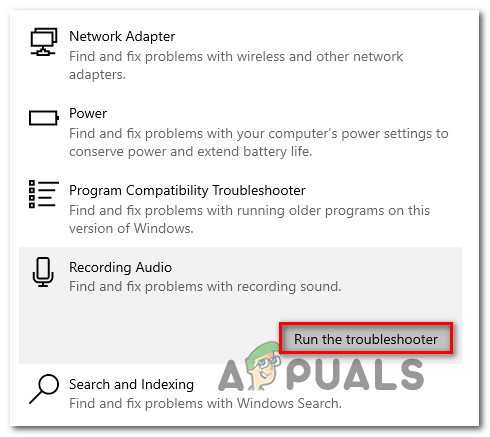Fix: Apex Legends Mic not Working
When your mic stops working in Apex Legends, it usually means the game isn’t detecting or using your microphone input, even though it might appear correctly in the settings menu. The most common cause of this issue is incorrect microphone privacy settings in Windows, where the game isn’t granted the necessary permissions to access your mic. Other potential reasons include outdated audio drivers, incorrect in-game audio settings, or issues coming from recent updates.

It’s important to ensure that your microphone is set as the default device in both Windows and the game’s settings.
Note: This article is not applicable if you’re experiencing microphone issues with multiple games or system-wide problems. In such cases, follow these articles.
Method 1: Run the Recording Audio Troubleshooter
Recording Audio Troubleshooter in Windows is designed to identify and fix common microphone issues automatically.
When you run this troubleshooter, it scans your system for potential problems like incorrect settings, outdated drivers, or misconfigured permissions that could be preventing your mic from working correctly in Apex Legends.
- Press Windows key + R to open a Run dialog box. Then, type “ms-settings:troubleshoot” and press Enter to open the Troubleshooting tab of the Settings app.

Opening the Troubleshooting tab of the Settings app via a Run box Note: If you’re on Windows 8.1 or lower, use this command instead: control.exe /name Microsoft.Troubleshooting.
- Inside the Troubleshooting tab, scroll down to the Find and Fix other problems tab, click on Recording Audio and click on Run the troubleshooter.

Running the Recording Audio troubleshooter - Select the device that you’re having trouble with, then hit Next to begin the troubleshooting process.

Selecting the Recording device from the list - Follow the on-screen prompts to investigate and apply the recommended repair strategies.
- Once the process is complete, restart your computer and see if the issue has been resolved at the next startup.
Method 2: Ensure that the Mic is set as Default in Windows Settings
Setting your mic as the default input device in Windows ensures that Apex Legends and other applications are using the correct microphone.
Often, if the mic isn’t set as default, the game might try to use another input device, leading to no audio being captured.
By confirming this setting, you make sure that your preferred microphone is prioritized and properly recognized by the system, eliminating any confusion that could prevent your voice from being picked up in-game.
- Press Windows key + R to open a Run dialog box. Then, type “ms-settings:sound” and press Enter to open the Sound menu of the Settings app.
- Inside the Sound menu, scroll down to the Input tab and change the drop-down menu associated with the Input device to the microphone that you’re actively using.
- While you’re here, test if the mic is operating normally under Windows by speaking into it. If the slider under Test your microphone is operating normally, it means that your mic is correctly configured.
- Launch the game and see if you are now able to use your mic while playing Apex Legends.

Modifying the Windows mic input
Method 3: Configure Origin Voice to Push-to-Talk
When you configure the voice chat to Push-to-Talk, you take control over when your microphone is active, which can bypass issues where continuous voice activation fails to work correctly.
This setting minimizes the risk of background noise or other inputs interfering with mic detection, ensuring that your voice is only transmitted when you press the designated key.
- Open the Origin launcher.
- Use the ribbon bar at the top of the application window to select Origin > Application settings.
- Inside the settings menu, expand the More tab and choose Voice from the list.
- First, ensure that the microphone you’re using is correctly selected under Device settings.
- Then, navigate to Voice activation settings and use the drop-down menu associated with Activation Mode to change it to Push-to-talk.

Activating Push to Talk from the Origin menu
Once these modifications have been made, launch the game and see if you’re now able to use the microphone while playing Apex Legends. If you still experience the issue, click on the gear icon (bottom-right corner) while in the main menu of the game, go to Settings > Audio and set the Voice Chat Record Mode to Push-to-Talk.

If you’re still unable to use your microphone while playing Apex Legends, but it’s operating fine in other applications, move on to the next potential fix below.
Method 4: Uninstall VoiceMode (if applicable)
Uninstalling VoiceMode, or similar voice-modifying software, can often fix the problem because these applications may interfere with how the game processes microphone input. Such software might hijack or alter the mic settings, leading to compatibility issues with the game’s voice chat system.
This is likely an incompatibility that will get patched as the game receives more hotfixes, but for now, the only way to address this conflict is to uninstall the application creating the problem.
- Press Windows key + R to open a Run dialog box. Then, type “appwiz.cpl” and press Enter to open Programs and Features.

Type appwiz.cpl and Press Enter to Open Installed Programs List - Inside the Programs and Files window, scroll through the list of applications until you find the voice-changing app/modulator that you think might be causing the conflict.
- Once you find it, right-click on it and choose Uninstall to remove it from your system.
- Follow the on-screen prompts to complete the uninstallation procedure, then restart your computer.
- At the next system startup, launch Apex Legends again and see if the issue has been resolved.
Method 5: Use a different USB port (if applicable)
If you’re using a USB-connected microphone, you might be able to resolve the issue by simply connecting the microphone to a different USB port and restarting the game. Several affected users have reported success with this method, with most of them saying that they had no issues afterward.
If you’re using a microphone that connects through USB, change the port it’s connected to and see if the issue resolves. If you have both USB 2.0 ports and USB 3.0 ports, downgrade or upgrade (based on your scenario).

Once the USB port has been changed, restart the game and see if the issue has been resolved.
Method 6: Lower the mic threshold (if applicable)
For some users, the reason their microphone was not working in Apex Legends was that its threshold was set too high in the Settings menu. Some affected users reported that the mic only worked when they shouted.
If this scenario applies to you, you might be able to resolve the issue by modifying the microphone threshold from the Settings menu. However, this option is only available if you’re using Voice Activation instead of Push-to-Talk.
- Open the Origin Launcher.
- Use the ribbon bar at the top to click on Origin, then select Application Settings.
- Inside the Application settings, click on the More tab, then choose Voice.
- Scroll down to Voice activation settings and bring the Microphone sensitivity slider closer to the right. But be advised that if you raise the level too far, all your sounds will be picked up, including your keystrokes.Note: This is a question of fine-tuning, so feel free to come back and adjust this slider after testing it in the game until you reach a level that you’re comfortable with.
- Once the Microphone Sensitivity slider has been adjusted, launch Apex Legends and see if your microphone is now working.

Adjusting the microphone sensitivity
Method 7: Adjust the Microphone Privacy settings
If the Microphone Privacy settings in Windows are too restrictive, Apex Legends might not have the permission it needs to use your mic. Adjusting these settings ensures that the game, along with other apps, can properly access and utilize your microphone.
This step is particularly important if you’ve recently adjusted your privacy settings or installed a Windows update, as it can restore the connection between your mic and the game, allowing you to communicate effectively in-game.
- Press Windows key + I to open the Settings app on Windows 10.
- From the home menu, scroll through the list of categories and click on Privacy.
- Next, use the left-hand panel to scroll down to App permissions, then select Microphone from the list.
- Move over to the right-hand pane and start by ensuring that the toggle associated with Allow apps to access your microphone is enabled.
- Then, scroll down to the list of applications and make sure that the Origin app is allowed to access your mic.
- If any modifications have been made, restart your computer and see if the issue has been resolved at the next startup.

Configuring Windows 10 to allow apps to use your microphone





